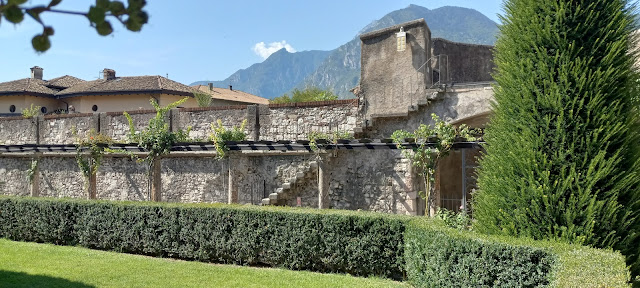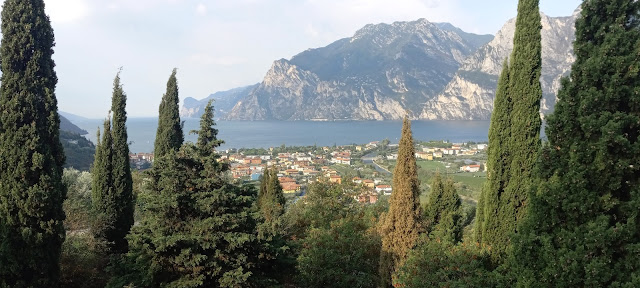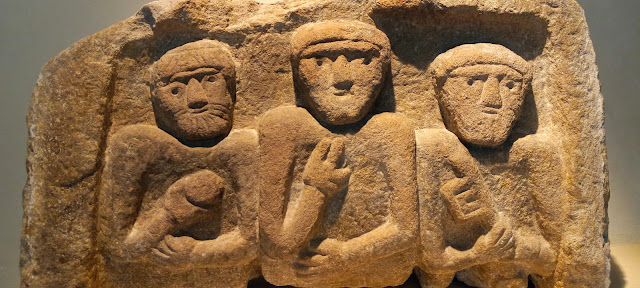A Fabulous trip to Trentino, South Tirol-Alto Adige and the Dolomites of northern Italy, an area between Milan and Venice. Names on the map in Tirol are the German version. i.e. Brixen=Bolzano, Meran= Merano, Bozen=Bolzano
I was so privileged to visit Italy with a small group of UC-Berkeley alumni for just a week, but we saw so much! We flew to Verona and then to our hotel in Trento for 6 nights and took excursions from there.
The view from my room looking in both directions was spectacular!
Every hillside is covered with vineyards and apple orchards (red and green delicious). The volcanic soil is very rich.
This region fell under Austrian rule for centuries before changing hands during World War I when it was annexed to Italy. It is an interesting blend of Mediterranean Italian, Alpine Austrian, Germanic and Ladino cultures in architecture, food, language and customs. Its unemployment rate is lowest in Italy.
The Castello del Buonconsiglio, built in many stages, was once the residence of the prince-bishops of Trento. It was the site where many treaties were signed and emperors crowned, as it was halfway between the Pope in Rome and the Hapsburgs and other Austrian leaders. The council of Trent met here to decide religious doctrine and other matters.
 Saturday we visited a touristy but charming town, Ortisei, in the lush green Val Gardena, and then took a long cable car ride to Alpe de Siusi, Europe's largest high-altitude plateau.
Saturday we visited a touristy but charming town, Ortisei, in the lush green Val Gardena, and then took a long cable car ride to Alpe de Siusi, Europe's largest high-altitude plateau.Unfortunately the Dolomites were somewhat cloud-covered, but still spectacular. The views were breath-taking.
Tamara (from Rome) was our wonderful and very knowledgeable local guide for several days
Bolzano is a charming small city, also in South Tirol
On the market square is the Capitello (center of photo) which set the standard of weights and measures for merchants. The pink limestone Roman Arena, on Piazza Bra, is 2000 years old, has perfect acoustics, seats 30,000, and is the most intact Roman theater because it has been in continual use. It is today the largest open air theater in the world, currently playing Aida.
We stopped at the small San Tomassino Church dedicated to San Vigilio, built in 16th century with frescoes honoring this saint who refused Diocletian's orders to kill Christians
As every day, we passed through valleys of vineyards and apples, to spend the day at Lake Garda, Italy's largest lake (between Verona and Trento), 1 1/2 hours from Trento. Our first stop was at Malcesine to visit the Castello Scaligero
A couple of us climbed the many steps to the top of the tower for great views. There were Etruscans there even before the Romans; there is a small Goethe museum there too.
Lots of sailing and especially windsurfing on Lake Garda. People pour into this area from Austria and Germany.
We had lunch (cheese, balsamic vinegar tasting and winery tour, too)
At the northern end is a town, Riva, where I bought a double scoop of gelato that was so big, so soft and so lopsided it fell off and everyone had to help me eat it!
There are fortresses and castles on hills and by lakes...hard to capture from the bus which raced around the many curves and through many long tunnels! Our bus drivers were amazing!
While some of our group spent our last day on a wine tour, and some walked around Trento, I took the train to Brixen/Bressanone, the most northern town almost to the border of Austria. Until WWI, this lovely town was Austrian. The border was moved, it became Italian, but the people are very Austrian and have resisted the change. I used German!
 The Hofburg was the bishop's palace with wonderful collections of Renaissance and medieval art and a large creche collection
The Hofburg was the bishop's palace with wonderful collections of Renaissance and medieval art and a large creche collection I loved the cathedral and Pfarrkirche, the winding streets and green hills surrounding the town. I think I could have stayed there forever!
I loved the cathedral and Pfarrkirche, the winding streets and green hills surrounding the town. I think I could have stayed there forever!When I got back to Trento I visited the Muse, beautiful new natural history museum, with everything from dinosaurs, to anteaters, to lions, to tropical plants, to glaciers, to a Lascaux Cave exhibit, to an ingenious Italian invention for hauling 18 litres of water in Africa, called a "Roto-Tanica and much more. Also views of the stadium, palace and city.
We had a farewell dinner after a very short week. The eggplant parmesan with pesto to the side and ricotta on top was one of my favorite dishes. So much good food!

Most of the group left at 3 am to drive to Verona to get our various flights. I flew on a small plane to Munich to wait for my huge Lufthansa plane to fly to Denver, to race through customs and to my far away gate to catch my flight to Salt Lake City. Whew! A great trip!! I had half a day to rest and then spent some of Labor Day weekend southeast of Provo with 4 of my kid's families in a nice but not air-conditioned house at Palisade Lake. The water was refreshing!
The kids enjoyed coating themselves and creating with the clay from the lake!





























































































































This blog is amazing, Miriam! Your energy, zest and knowledge and photography and writing skills are UNREAL! Thank you!
ReplyDelete